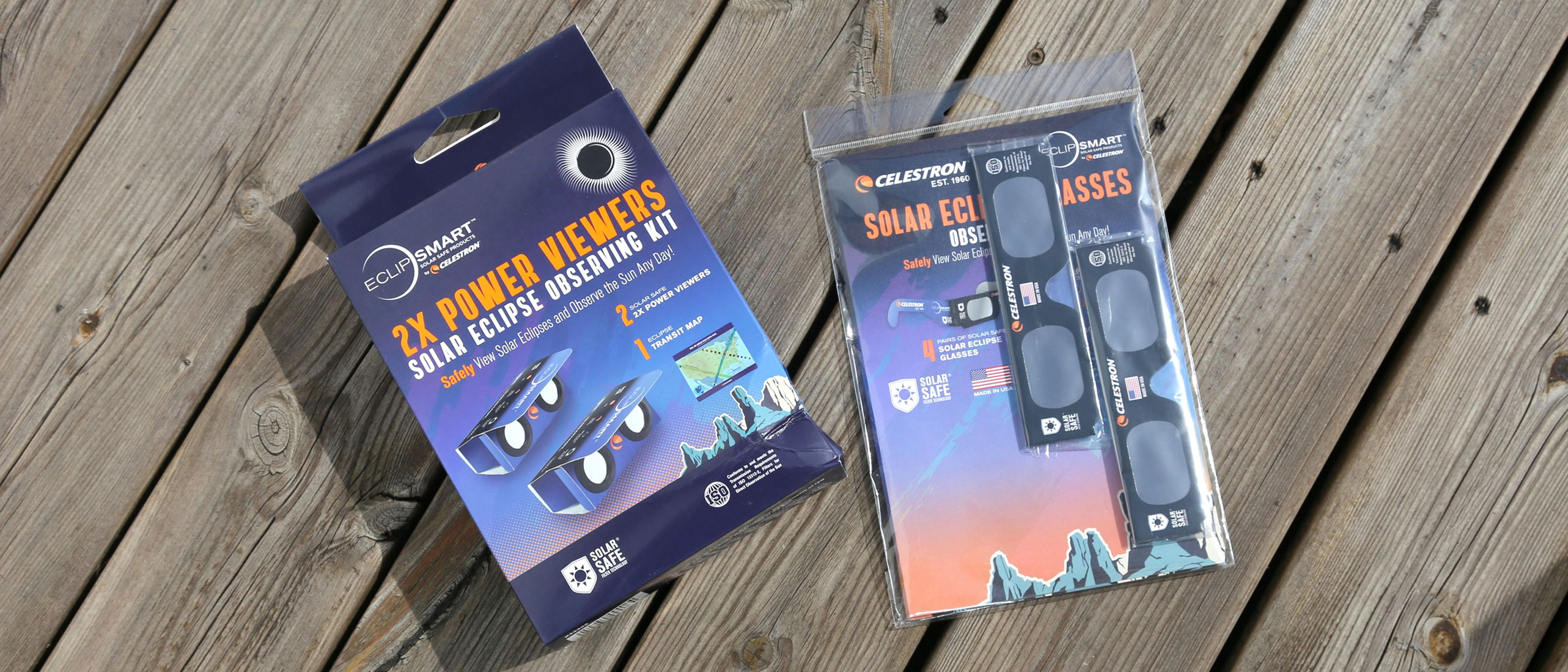Space Verdict
The Celestron EclipSmart 2x Power Viewers Solar Eclipse and the Celestron EclipSmart Solar Eclipse Glasses Observing Kit combine booklets, maps and solar-safe ways of viewing the sun, with the latter offering some useful magnification.
Pros
- +
Compliant with ISO 12312-2
- +
Power Viewers offer 2x magnification
- +
Sharp, clear views of the solar disk
- +
Orange tint to the sun
Cons
- -
Travel pouches would be helpful
- -
Power Viewers can produce double-vision
- -
Solar eclipse map is slightly confusing
Why you can trust Space.com
Solar eclipses are potentially dangerous. Staring at the sun with naked eyes can cause solar retinopathy — burns to your retinas — that will leave you with a case of 'eclipse blindness' that can last beyond the event. Luckily, there's a really simple solution — solar eclipse glasses. In preparation for the 'ring of fire' annular solar eclipse on Oct. 14, 2023 and the total solar eclipse on Apr. 8, 2024, both of which will be visible in North America, Celestron has readied the Celestron EclipSmart 2x Power Viewers Solar Eclipse Observing Kit and the Celestron Solar Eclipse Glasses Observing Kit, both of which are aimed at giving eclipse-chasers not only protection, but also information on exactly where to be to have the best views either of the 'ring of fire' (October 14, 2023) and of totality (April 8, 2024).
Here's what you need to know about these two packages being sold especially for the two upcoming solar eclipses.
Celestron EclipSmart 2x Power Viewers Solar Eclipse and Solar Eclipse Glasses Observing Kit review
Celestron EclipSmart 2x Power Viewers Solar Eclipse/Solar Eclipse Glasses Observing Kit: Design
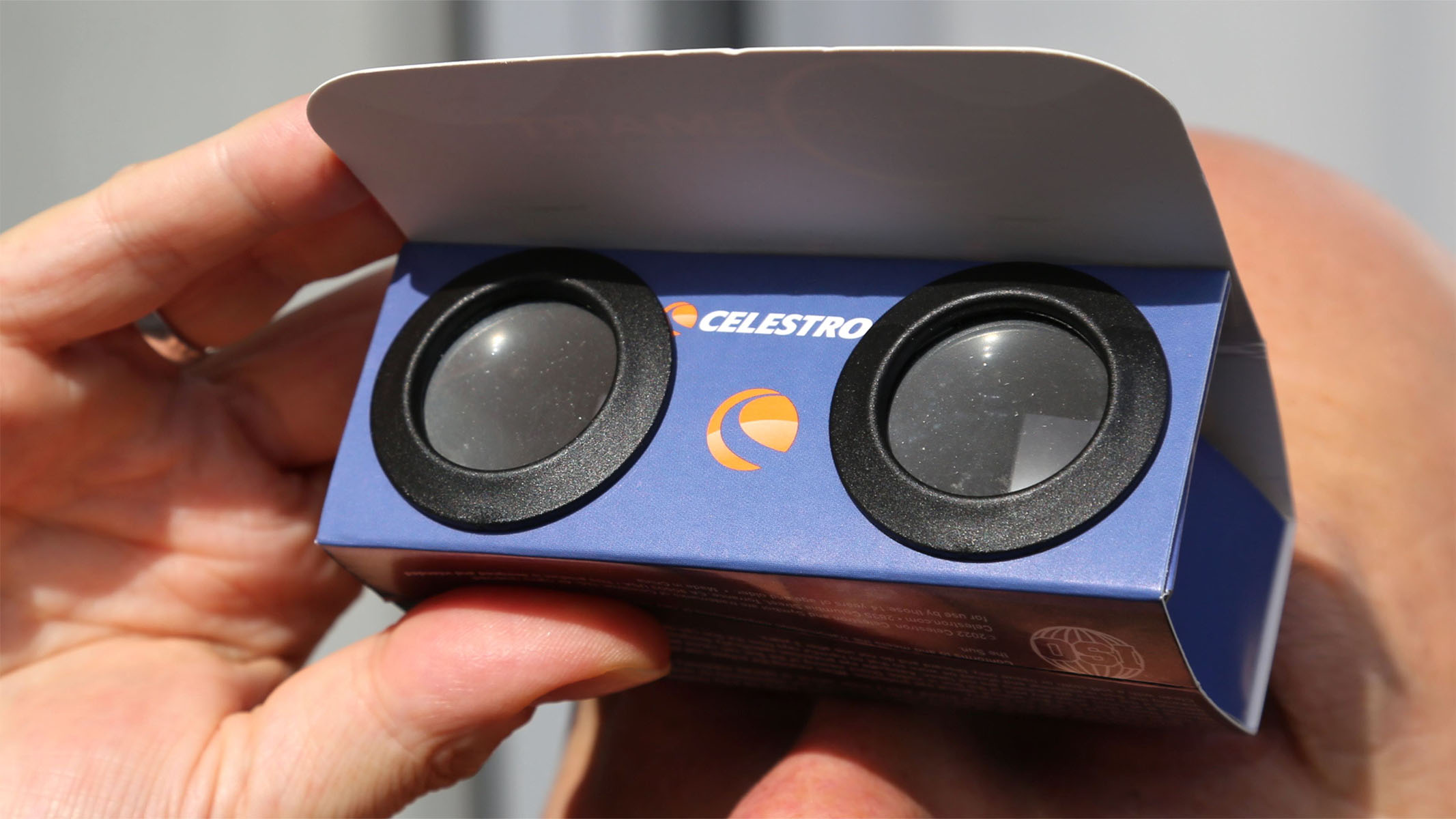
- Comply with ISO 12312-2
- 4x pairs solar eclipses glasses/2x pairs Solar Power Viewers
- Books and maps included
Although both contain solar eclipse glasses that comply with the ISO 12312-2 international standard, these two packages are designed to appeal to slightly different markets.
The Celestron Solar Eclipse Glasses Observing Kit, which costs US$11.95, contains everything required for four people to learn everything they need to know about the two upcoming solar eclipses and stay safe while viewing them. In the package are four pairs of solar eclipse glasses from American Paper Optics. They're wrapped in packs of two. Each pair is black with a U.S. flag between the eyes and a Celestron logo, which also adorns the arms.
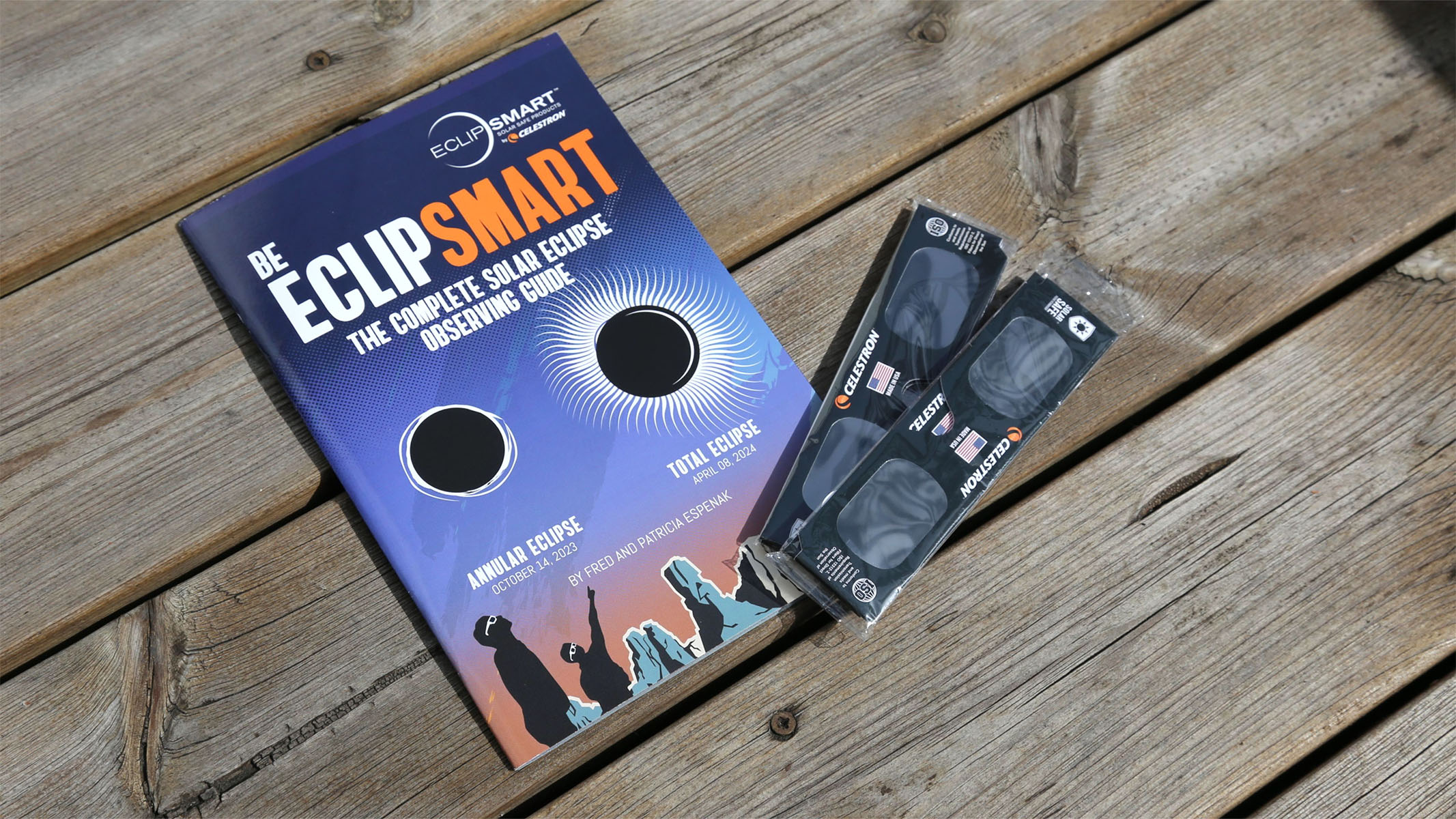
Celestron EclipSmart 2x Power Viewers Solar Eclipse Observing Kit:
- 2x Solar Power Viewers
- Double-sided eclipse map poster
Celestron Solar Eclipse Glasses Observing Kit:
- 4x pairs solar eclipse glasses
- Be EclipSmart: The Complete Solar Eclipse Observing Guide by Fred and Patricia Espenak
Inside they're plain. Most importantly, they contain polymer solar-safe filters. Also in the package is an A5 book entitled Be EclipSmart: The Complete Solar Eclipse Observing Guide. A 50-page booklet, it's authored by Fred Espenak (also known as 'Mr Eclipse' and who used to compute the paths of solar eclipses for NASA) and Patricia Espenak, who's witnessed dozens of solar eclipses.
The Celestron EclipSmart 2x Power Viewers Solar Eclipse Observing Kit, which costs US$12.95, is a slightly different product, comprising a couple of pairs of what Celestron calls Solar Power Viewers.
These are a slight step up from basic solar eclipse glasses in that they introduce a modicum of magnification thanks to the use of plastic lenses with solar-safe filters in front. They're made of cardboard and are foldable. Also in the package is a double-sided eclipse map poster.
Celestron EclipSmart 2x Power Viewers Solar Eclipse/Solar Eclipse Glasses Observing Kit: Performance
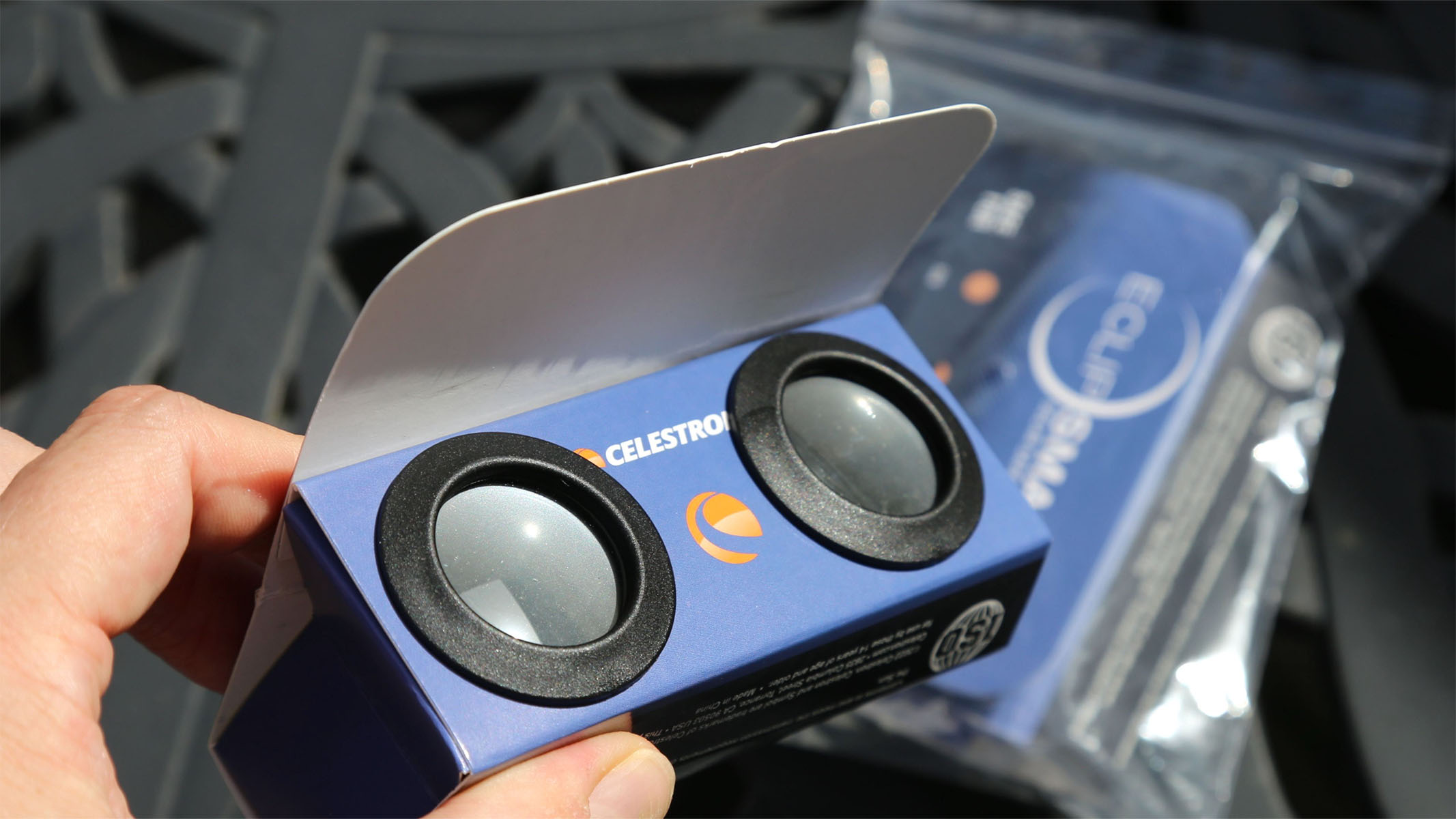
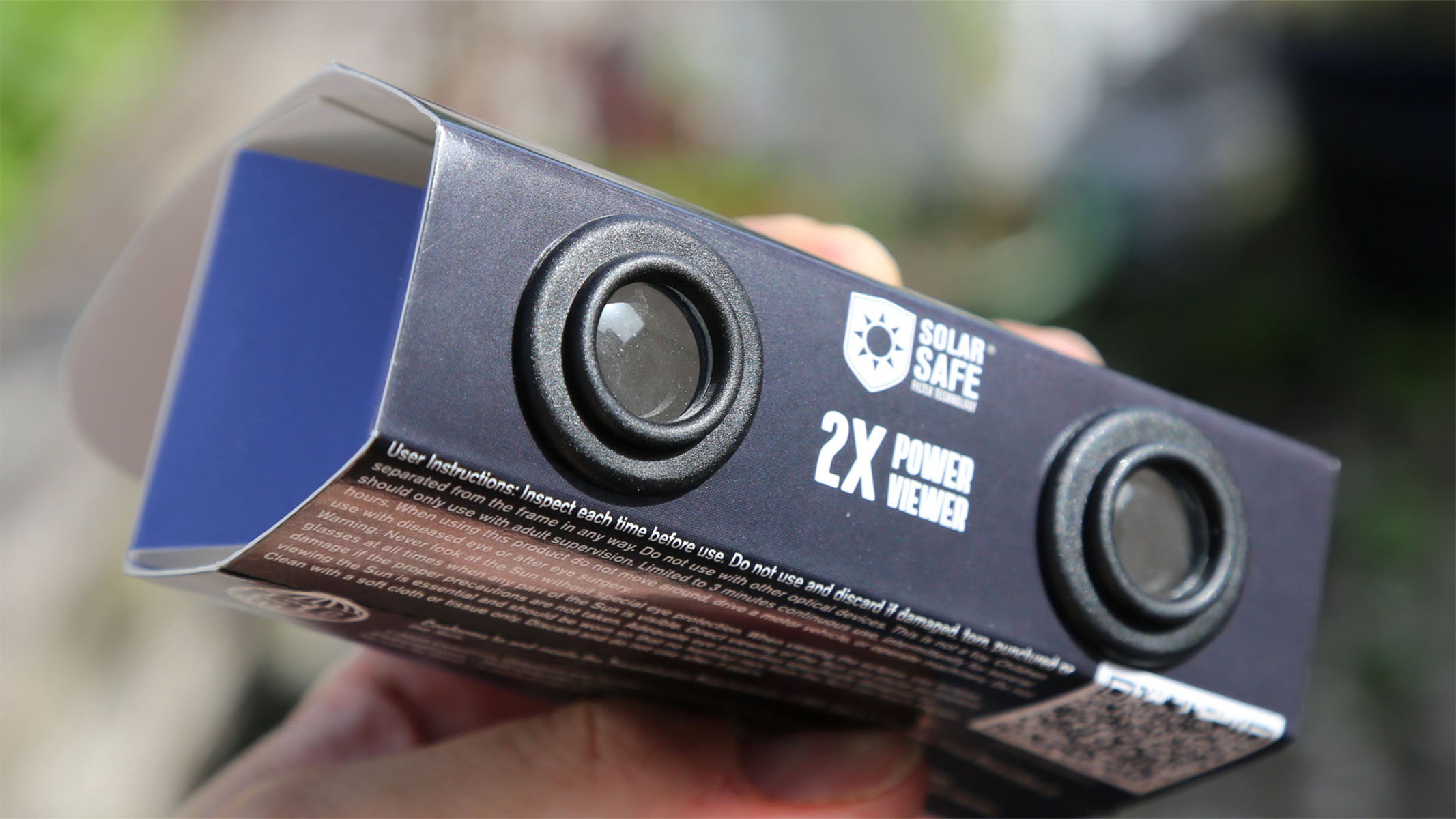
- Polymer lenses
- Sun looks orange
- Power Viewers give 2x magnification
Both of these products use scratch-resistant polymer lenses that filter out 100% of ultra-violet and infrared rays and 99.999% of intense visible sunlight. They both make the sun look orange. That makes them different to solar eclipse binoculars also in Celestron's EclipSmart range, which use mylar and make the sun appear bluish-white.
Using the Celestron EclipSmart Solar Eclipse Glasses to view the sun is no different from using any modern pair of eclipse glasses; you see a very small, orange sun against a black background. There's a small amount of glare and it's very difficult to see any sunspots. But it's a great view.
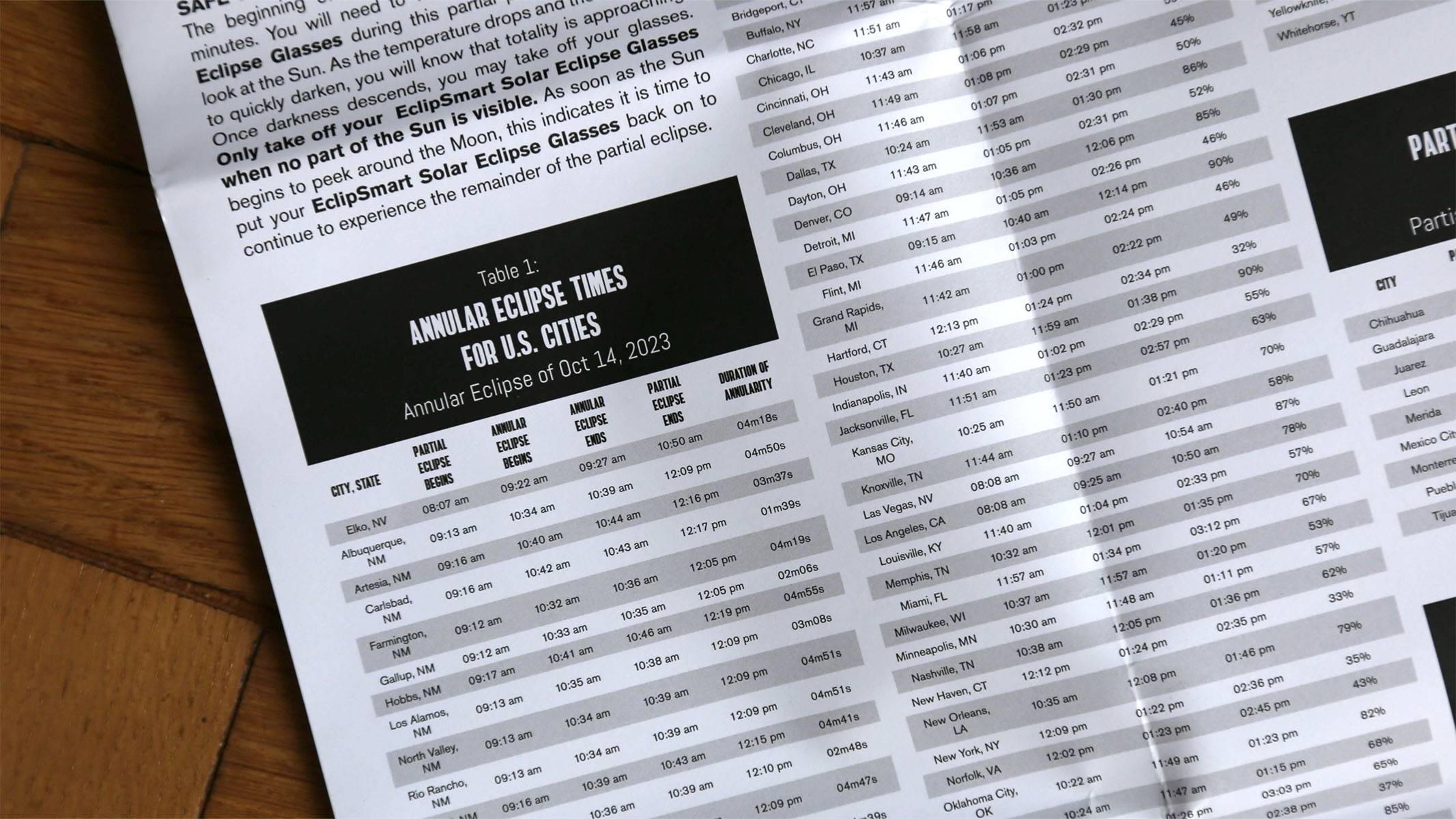
The Celestron EclipSmart 2x Power Viewers are aimed at those wanting a close-up without having to use solar eclipse binoculars. They're basically two small lenses ranged in front of two larger solar filters. They use the same polymer material, so the sun still looks orange, but this time it's just possible to see faint sunspots on the sun's disk (as well as wispy clouds floating across it). The only potential issue is double-vision. Since the distance between the lenses is fixed it's not possible to alter the interpupillary distance. However, by pinching the cardboard housing I found a position where I could see the sun as one slightly magnified image.
For both designs, it's best to keep them safely wrapped up in plastic until the big day. Even a pinhole in the filters — which can be caused just by dropping them on a lawn — can direct a dangerous amount of sunlight onto your retina. If you can see your eclipse glasses are torn, scratched, or coming loose from the cardboard, definitely don't use them.
Celestron EclipSmart 2x Power Viewers Solar Eclipse/Solar Eclipse Glasses Observing Kit: Functionality
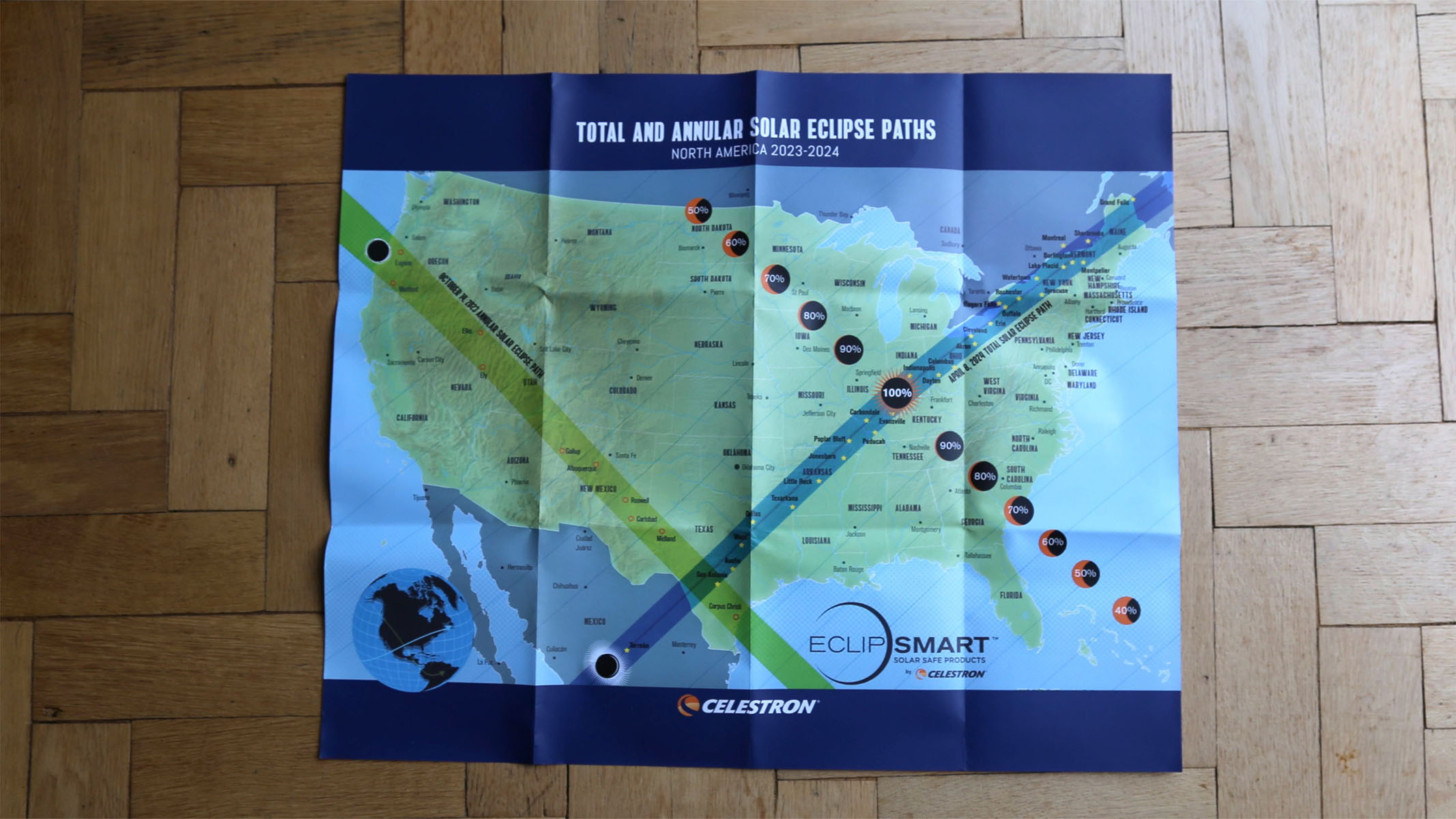
- Excellent booklet
- Helpful eclipse timings by location
- The map is slightly confusing
Although the main reason to buy these packs from Celestron is to get your hands on some solar eclipse glasses, both packages contain some impressive informational resources.
Shipping only with the Celestron Solar Eclipse Glasses Observing Kit, the Espenaks' Be EclipSmart: The Complete Solar Eclipse Observing Guide is excellent. Colorful and expertly written, there are simple explanations of what an eclipse is and why and when they occur through to the difference between an annular and a total solar eclipse. There's a brief delve into the history of eclipses and a focus on staying safe. Perhaps the most useful section — aside from the pull-out maps of the paths of both eclipses — is a checklist of eclipse day essentials (sunscreen, hat, full tank of gas .. and plenty of solar eclipse glasses). The final 10 or so pages include times of both the partial, annular and total phases for the two eclipses for cities in and out of the paths. It's a book with a well-judged mix of fun facts, brief explanations and more in-depth detail for those who want it.
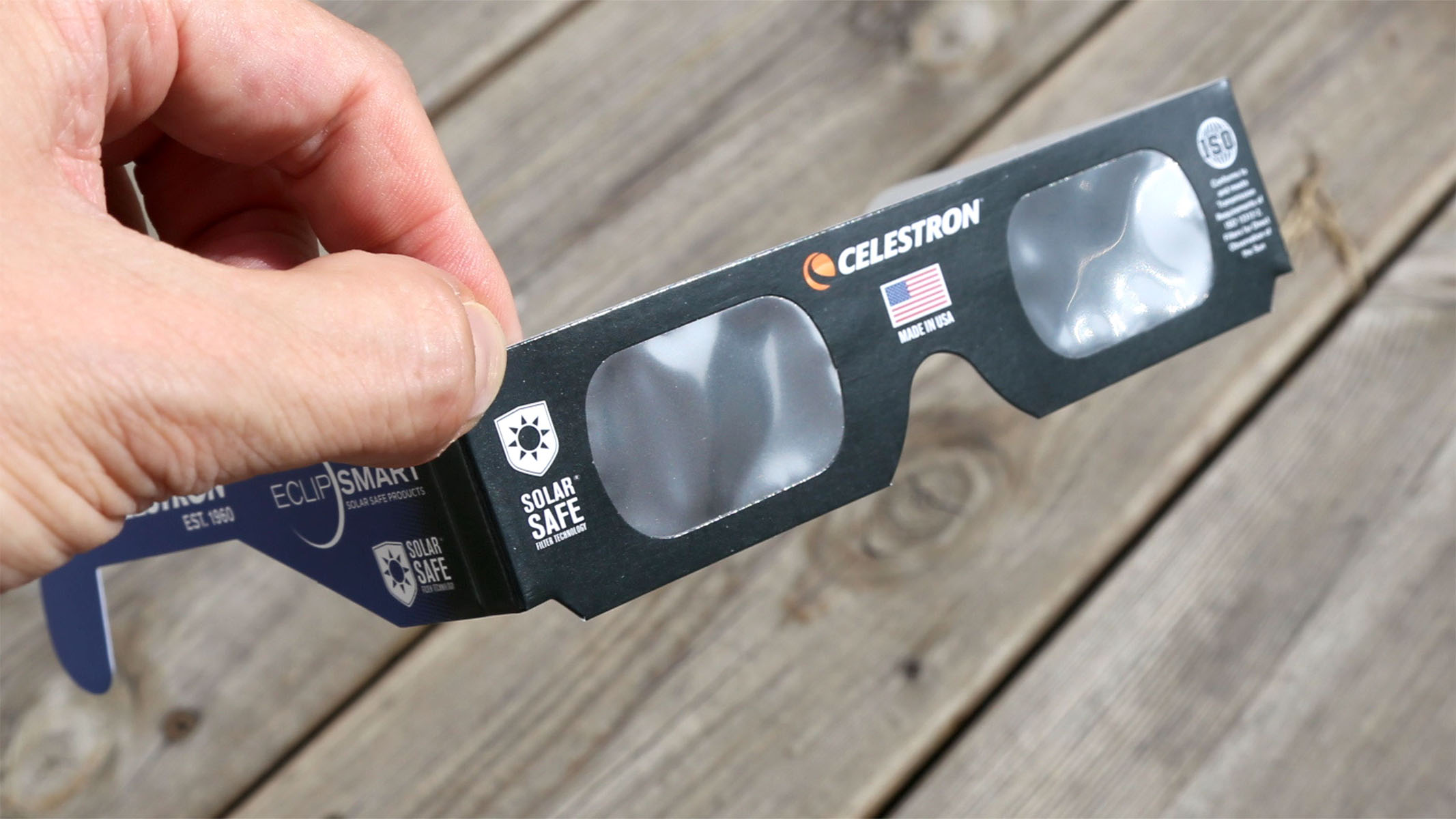
In the box with the Celestron EclipSmart 2x Power Viewers Solar Eclipse Observing Kit is a foldout map. Laminated and tough, it shows a map of the U.S. with both parts of the eclipse upon it. Sadly, for the 2024 total solar eclipse, it omits the Pacific Coast of Mexico, specifically Mazatlán, where many eclipse chases from all over the world will be headed. It also doesn't include much of Atlantic Canada, Toronto, Montréal, Sherbrooke and Grand Falls are marked on the map.
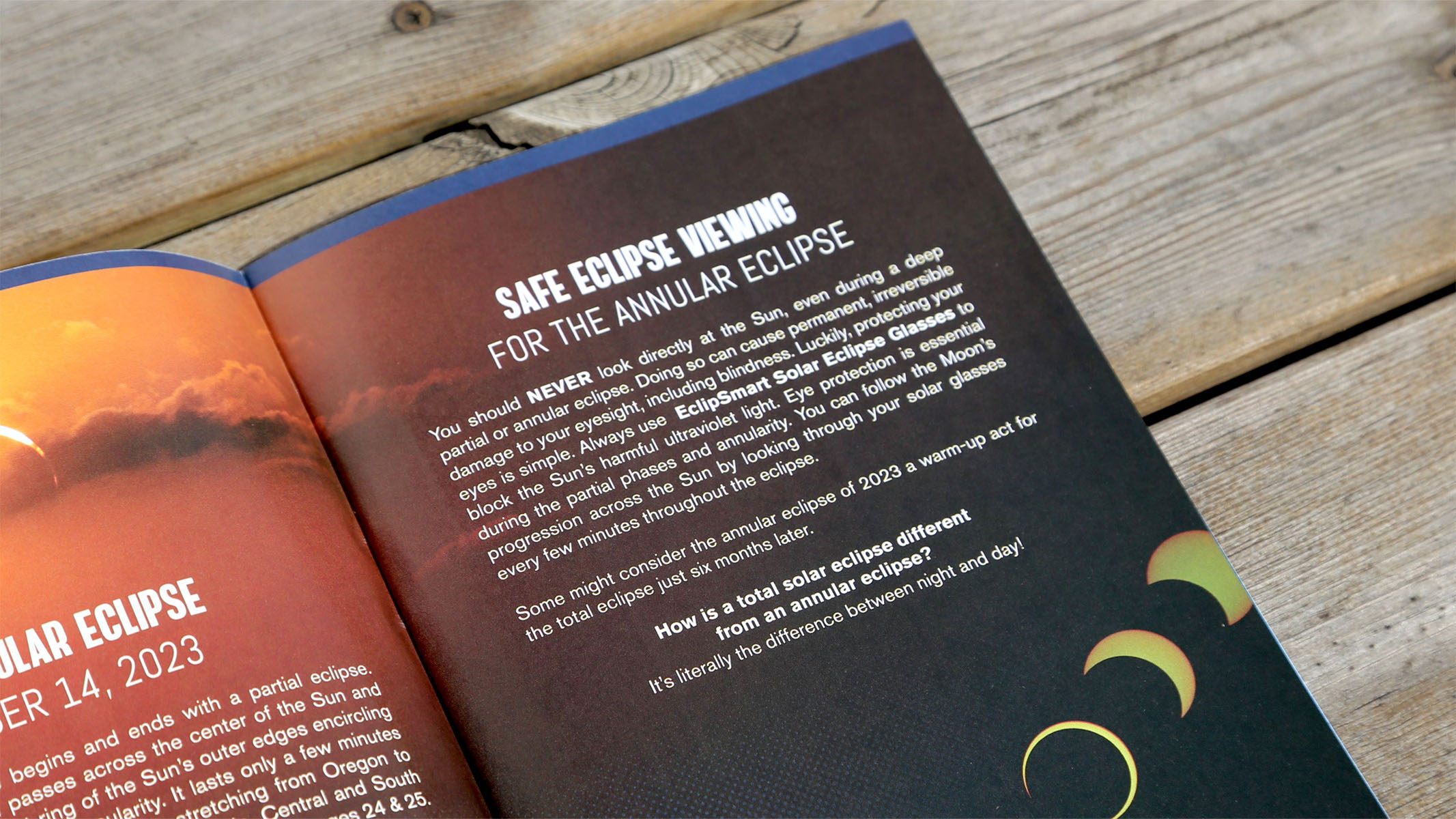
Although it's an excellent map for using for the 2024 total solar eclipse — with plenty of major towns and cities marked upon it — it does rather neglect the 2023 annular solar eclipse. For example, for 2024's event it shows the zones where 90% partial solar eclipse will be seen and an 80%, 70%, and so on. However, those same lines of division also cross the path of the 2023 event, which adds some confusion. On the reverse of the map is the annular, total and partial solar eclipse timings for Mexican cities and Canadian cities as well as for U.S. cities.
Should you buy the Celestron EclipSmart 2x Power Viewers Solar Eclipse and Solar Eclipse Glasses Observing Kit?
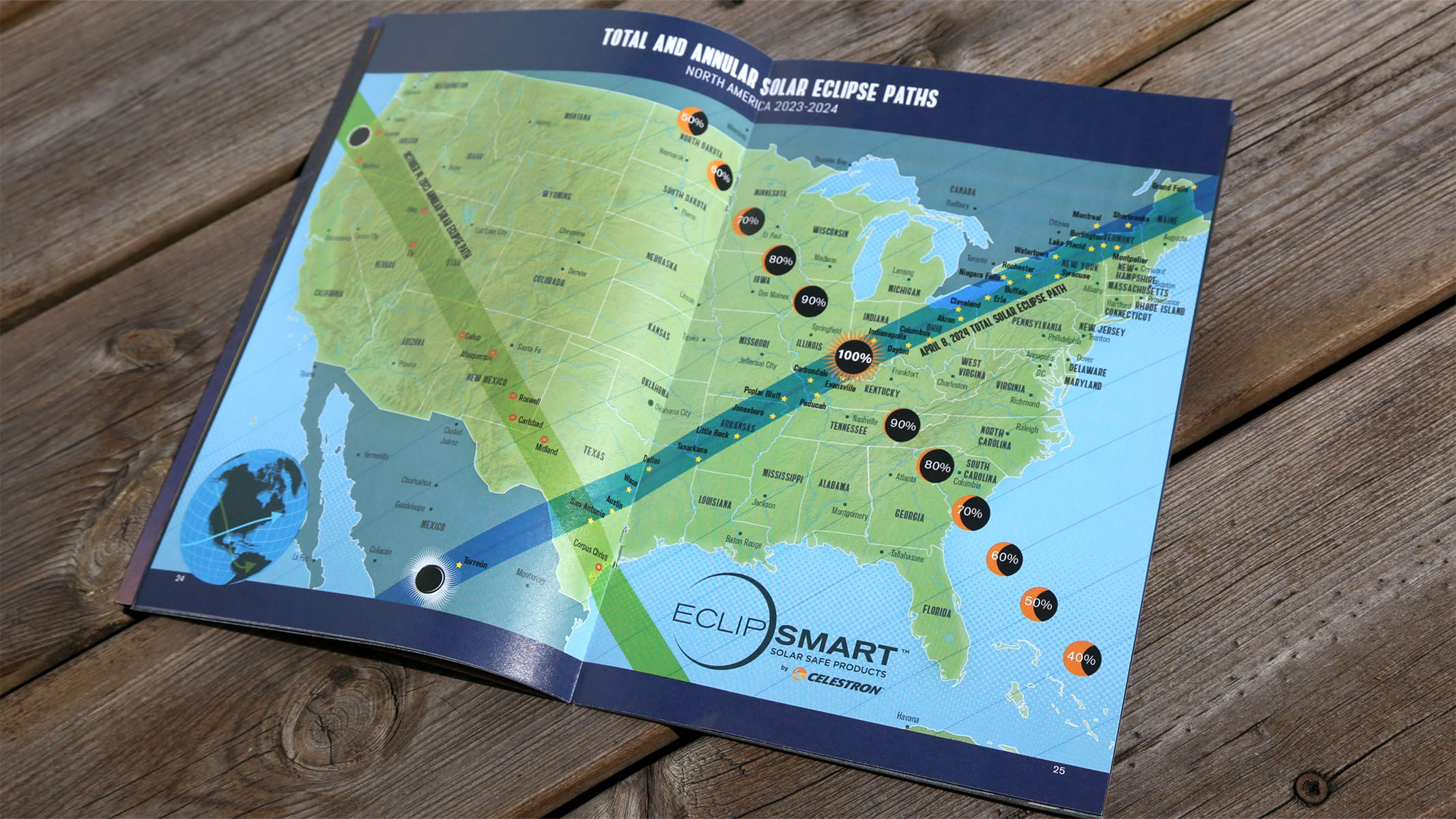
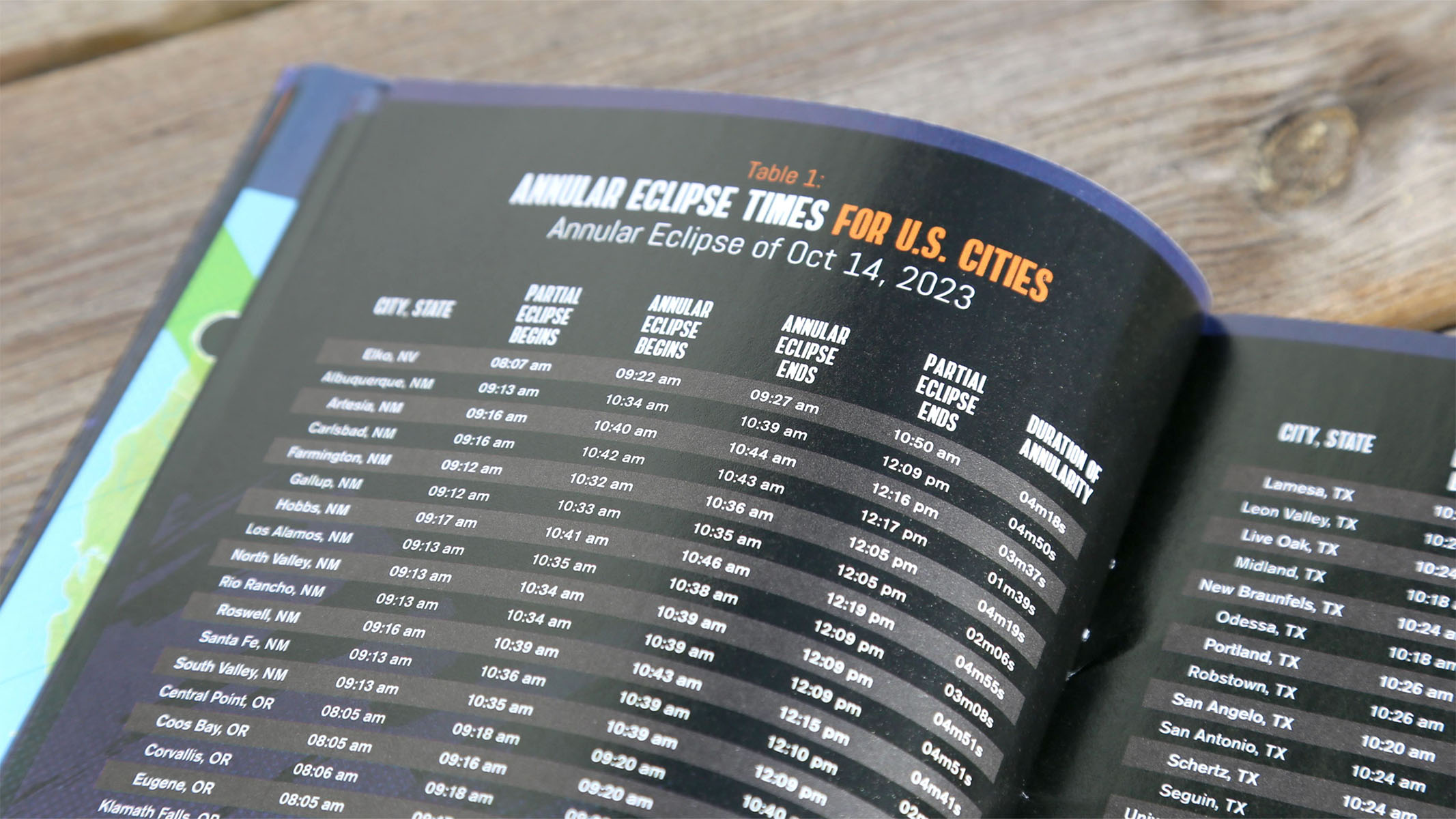
Eye protection is essential to enjoy any solar eclipse. During the total solar eclipse on April 8, 2024, there will be a brief period of totality when the sky darkens and the sun's disk is completely covered by the moon. Only during these few minutes is it safe to look at the eclipse with the naked eye.
During all other phases of both that total solar eclipse, and for all phases of the annular solar eclipse on October 14, 2023, eclipse glasses are essential. That advice stands whether you are in the path of the central path of either eclipse or to the side, where you will experience a partial solar eclipse. That makes these packages really useful to everyone in North America, though each package does have a slightly different market.
For example, if you don't know much about the upcoming eclipses and you want to find out as much as possible in advance — and you want eye protection for up to four people — then the Celestron EclipSmart Solar Eclipse Glasses will suit. However, if you're traveling as a couple, you've already seen a solar eclipse and want something slightly higher-end — and the idea of a souvenir map appeals to you — then the Celestron EclipSmart 2x Power Viewers is best for you. After all, the latter provides less information but offers a slightly upgraded way of safely watching solar eclipses.
If the Celestron EclipSmart 2x Power Viewers Solar Eclipse and Solar Eclipse Glasses Observing Kit aren't for you
Solar eclipse glasses are widely available, but as the big day gets closer, stocks tend to run dry. It's therefore advisable to stock up in advance and get your eclipse glasses purchased well ahead of time. Wherever you get them, make sure they comply with the ISO 12312-2 international safety standard for filters for direct viewing of the sun. There can be problems with counterfeit eclipse glasses labeled as if they're ISO-compliant, so only use vendors listed on the American Astronomical Society's Reputable Vendors of Solar Filters & Viewers page, which have all been vetted by the AAS Solar Eclipse Task Force.
Want to get a closer look at solar eclipses or just a more detailed view of the sun? Try our Celestron EclipSmart Travel Solar Scope 50 telescope review, Celestron EclipSmart 12x50mm porro solar binoculars review or Celestron EclipSmart 10x25mm roof solar binoculars to each of which we've given four out of five stars during testing.
Join our Space Forums to keep talking space on the latest missions, night sky and more! And if you have a news tip, correction or comment, let us know at: community@space.com.

Jamie is an experienced science, technology and travel journalist and stargazer who writes about exploring the night sky, solar and lunar eclipses, moon-gazing, astro-travel, astronomy and space exploration. He is the editor of WhenIsTheNextEclipse.com and author of A Stargazing Program For Beginners, and is a senior contributor at Forbes. His special skill is turning tech-babble into plain English.
